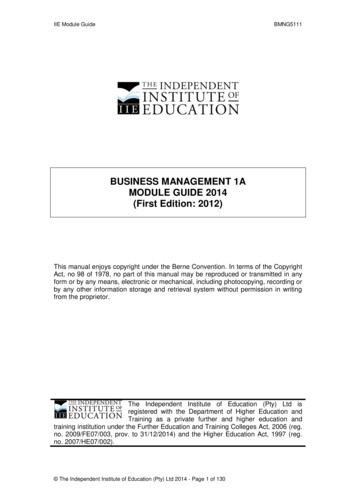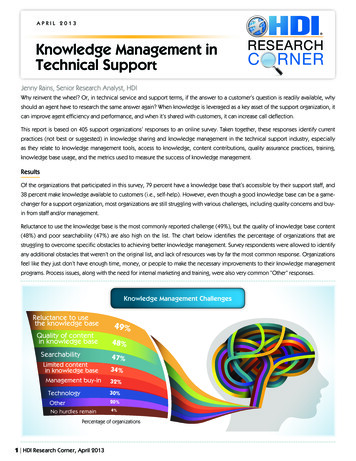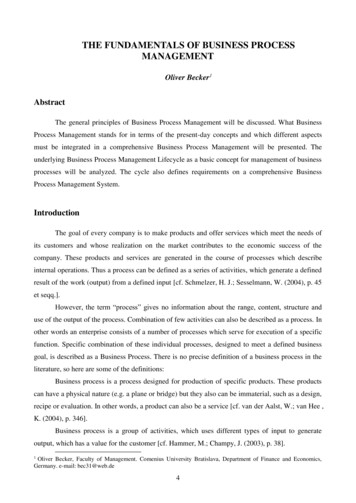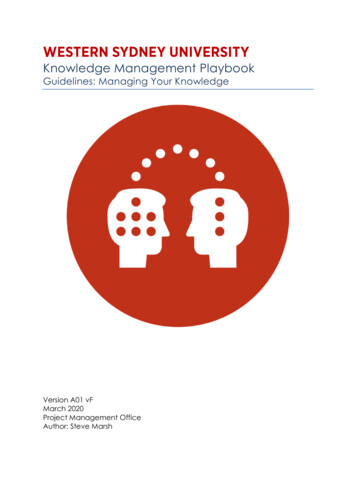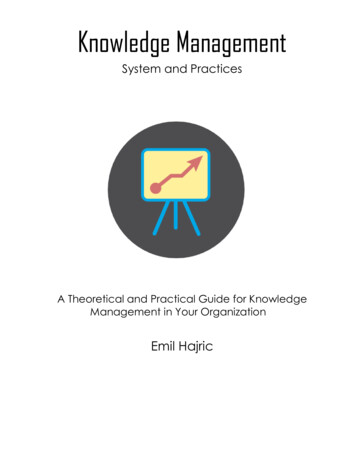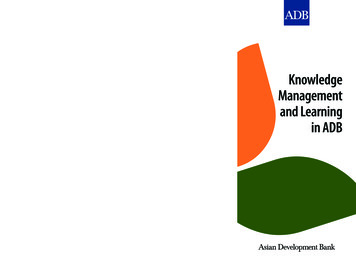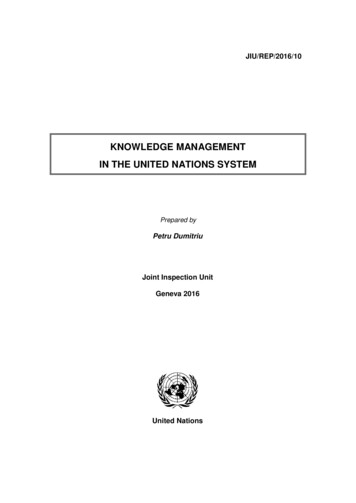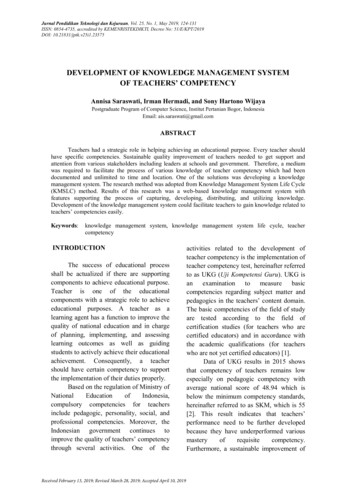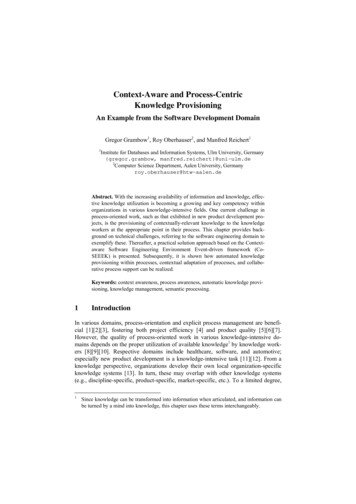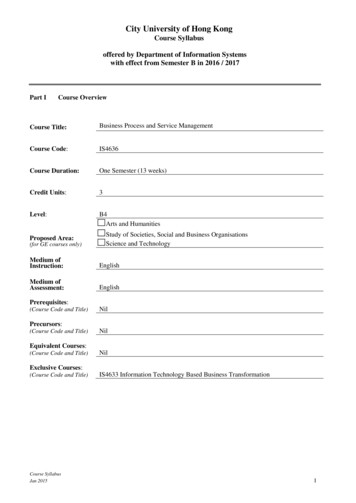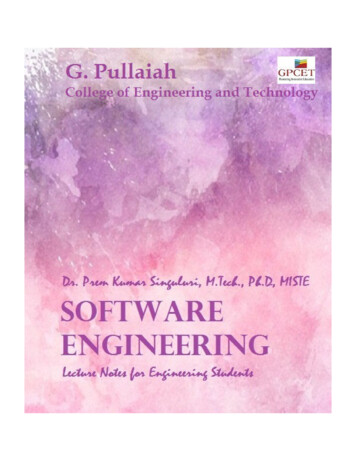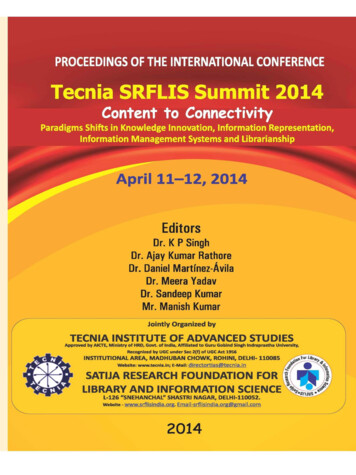
Transcription
Knowledge Management and Business Process Reengineering1Ajay Kumar RathoreAbstractKnowledge management has recently become a trendy concept. Information and CommunicationTechnologies (ICT) were thus positioned as a strategic resource that enables automation, monitoring,analysis and coordination to support the transformation of business processes. Business ProcessReengineering (BPR) is a strategy of redesigning business operations to take full advantage of informationtechnology and human resources. BPR is a management tool which became popular together with the genericprocess management philosophy of lean manufacturing. Business process reengineering has become a viableway of implementing lean structures. The concept at the core of the BPR is the need to stay competitive.Business process reengineering is complex and challenging. Many organizations are trying to switch over toknowledge management and develop a knowledge management strategy, often alongside ongoing BPR. KMincludes a set of tools, such as social network analysis, gatekeeper theory, knowledge audit, process mappingand optimization, knowledge asset deployment, knowledge sharing improvement, informal network planning,communications design, development of networks of excellence and communities of practice, and successionplanning.Keywords: Knowledge Management, Business Processing; Business Processing Reengineering1Director, Tecnia Institute of Advanced Studies, New Delhi
Integrated Knowledge Management and Engineering123Ankita Singh Pushpendra Singh Priyanka Pandey Yogesh Sharma4AbstractKnowledge is one of the key issues in every business today. Computer based support is getting increasingimportance here. This has currently mainly two main objectives: knowledge management and knowledgebased systems. The complexity of engineering knowledge results in high requirements to the knowledgestructuring and retrieval techniques to be used here. It is also valuable as a first phase in the lifecycle ofknowledge based engineering systems. An Informal Model is introduced here as a representation ofknowledge suitable for engineering knowledge management as well as to support the development ofKnowledge based system. Knowledge management is a comprehensive process of knowledge creation,knowledge validation, knowledge presentation, knowledge distribution and knowledge application. In thispaper, knowledge management has been explained in general. Then an application of KnowledgeManagement in engineering has been attempted to explain. The paper proposes a knowledge management toachieve a competitive control of the machining systems. The model can be used by the manager for thechoosing of competitive orders.Keywords: Knowledge, Knowledge management, Knowledge engineering.1Librarian, IEC Group of Institutions Gr. Noida. E-mail: ankimahi@gmail.comAssistant Professor, H.R. Group of Institutions, Ghaziabad. E-mail:ajaypushsingh1907@gmail.com23Assistant Professor, IEC Group of Institutions, Gr. Noida. E-mail: priyamaggi@gmail.com4Assistant Professor, H.R. Group of Institutions, Ghaziabad. E-maii: ysharma788@gmail.com
Information Visualization and Information Retrieval in CATIA V5: Core Features andPossibilities of Definitions within the System1Daniel Martínez-ÁvilaAbstractCATIA, Computer Aided Three-dimensional Interactive Application, is one of the most important commercialsoftware used for Computer Aided Design (CAD), Computer Aided Engineering (CAE), and Computer AidedManufacturing (CAM) in the aerospace and automotive sectors. This study analyzes the main core featuresfor Information Visualization, Information Retrieval and Information Organization of the main CADworkbenches in CATIA V5 that will facilitate the development of new PLM features via external applications,and simple ways of defining new schemes for descriptions and exportation of records within the system. Thispaper proposes an easy way to define and load standardized schemes (other than the ISO 10303-209 STEPAP that is included by default) without any kind of API or external application.Keywords: CATIA V5, CAD, Customization, Visualization, Retrieval, Metadata.1University of Wisconsin-Milwaukee, School of Information Studies. E-mail: avilad@uwm.edu
Theories of Knowledge Management123Dimpy Handa Garima Rajeev GuptaAbstractKnowledge Management (KM) as an organizational novelty is more than a decade old. As a discipline,it has developed to a stage where we can now differentiate the principles and practices that make itexclusive. This theoretical paper is based on the extensive literature already existing on KM. The paperattempts to throw some light on the concept of knowledge and its uniqueness that called for theinnovation of KM theories and practices. This paper outlines a brief history of KM concepts, noting thatKM existed even before the term came into picture. We believe that to be reliable, KM system’sdevelopment should be built upon the significant theories of KM that exists in different related fields.We have promoted this view in this paper by providing a review and interpretation of KM theories indifferent fields. In pursuance of this objective we attempt to comparatively analyse key tenets of presentday models of KM theories. The paper presents theories of KM as propounded by Von Krogh andRoos,Nonaka and Takeuchi, M. Choo, and Boisot.Keywords: Knowledge, Knowledge Management, Spiral Model, Organizational Epistemology,Sense- Making Model and I-Space Model.1Department of Commerce, Delhi School of Economics, DU, Email: handadimpy@yahoo.com Phone No.: 09891156233Assistant Professor, Zakir Husain Post Graduate College (E),DU , Email: diwakargarima@yahoo.in Phone No.:09999642354 Department of Commerce, Delhi School of Economics, DU, Email: rajeevguptadse@gmail.comPhone No.: 0989180284323
Role of Knowledge Management in Organizations' Improvement1Hamid SaremiAbstractWith the passage of the Industrial Revolution and enter into the new millennium, the of organizations'engines are not any more limited to capital and human force. The most important multilateral organizationsdevelopment and businesses is set of skills and in the present age is knowledge. Knowledge of its truemeaning is a set of human abilities that is concomitant with awareness and information of better productionmethods. Application of such perception towards knowledge is widespread in the current and futureorganization. Thus organizations are after correct and timely utilization of their knowledge resources andthe surrounding environment. Such an approach has developed a new concept known as KnowledgeManagement (KM). The tool that trussed to is developed implement Knowledge Management more inorganizations is information technology and communication. One of the factors influencing in theacquisition competitive advantage and collective resources is knowledge. This paper intends to study therole of Knowledge Management in organizations and its impact on organizational effectiveness increase.The main objective of Knowledge Management in the organization is create, gain, saving ,issuing , sharingand applying knowledge, a knowledge that can be helpful and considered as effective resource in the time ofplanning and making decisions. The Knowledge Management is human hidden capital of Organization.Nowadays, organizations should not only consider their financial resources as capital but also theemployees knowledge of an organization is enumerated as their most important capital. The management ofan organization must effectively manage and invest in this area to increase the effectiveness andimprovement of business.Keywords: Knowledge, Knowledge Management, Human Capital, Organization, Employees.1Professor in Financial Management Vice- Chancellor of Islamic Azad University of Iran -QuchanBranch Email: hadi sarem@yahoo.com
Strategies for Creating New Businesses: A Sociocultural and Institutional Approach1José G. Vargas-HernándezAbstractThis paper aims to summarize the main theories from socio-cultural or institutional approach toencourage the creation of new businesses. Given this context, it raised the importance oftheoretical study of the factors that influence decision making in the development of newbusinesses and how it affects the environment in which they operate the same business. Theresearch method used is to review the existing literature by analyzing the major theories involvedin the creation of companies emphasizing the socio-cultural approach. The analysis concludes theactivity of entrepreneurship to encouraging the creation of companies, being an important factorin economic development.Keywords: Entrepreneur, company, socio-cultural approach, theoriesonthecreation ofcompanies.1University Center forEconomic and Managerial Sciences, University of Guadalajara, Zapopan, Jalisco, 45100,México, Tel. 52 3337703340 Ext. 25685
A Comparative Study of Normalized Cut Method and Random Walker Method12Monica Arora Santosh KumarAbstractPartitioning of image into different regions that are homogenous according to some predefinedcriterion is the chief characteristic of image segmentation. Segmentation is the first and mostimportant step in numerous areas of image processing. In this paper, the comparative study of twoimage segmentation methods – normalized cut method and random walker method – is done.Normalized cut method is used to minimize the disassociation and maximize the association in theimage pixels. It takes into account both similarity within groups as well as dissimilarity acrossgroups. Random walker method is used to determine the labels ( i.e. object or background ) toassociate with each pixel. Both the methods are used to minimize the graph cut.Keywords: Graph Cut, Image Processing, Image Segmentation, Normalized Cut Method,Random Walker Method.1 2- Department of Electronics & Communication Engineering Invertis University, Bareilly, UP, E-mail:monica20arora@gmail.com
Data Mining: An OverviewPrerna Kashyap1AbstractThe present paper is deals with the concept of data mining and guidelines for successful data mining, datamining process as : State the Problem, Collect the data, Preprocess the data, Estimate the model, Interpretthe model and draw conclusions. Describe the various data mining software: commercial software as well asfree software in details. Different Data Mining Techniques like Classification, cluster analysis, Prediction,Association Rules Mining, Text and Web Mining has been discussed. The paper also discuss the applicationof data mining in library and information ScienceKeywords: Data Mining, Data Mining Process, Data Mining Software, Mining Techniques1Assistant Librarian, Central University of Punjab, Bathinda-151001 E-mail:prernakumari@rocketmail.com
Implementation of Knowledge Driven Innovations1Rajesh BajajAbstractIn changing work environments, innovation is imperative. Yet, many teams and organizations fail to realizethe expected benefits of innovations that they adopt. A key reason is not innovation failure but implementationfailure. The failure to gain targeted employees’ skilled, consistent, and committed use of the innovation inquestion is many times attributed to inadequate understanding, exploration and application of the availableknowledge. In present day context, where knowledge domain is continuously on change due to modifications,improvements and up gradation; it is very necessary that structured knowledge sifting, adopting the usefulaspects and creating most user friendly applications by the entrepreneurs are resorted to. Having achievedthe commercially viable innovation alone is not a surety to success. Innovation implementation has numerousobstacles, attributed to internal as well external stake holders. Thus the whole chain i.e starting withknowledge search to innovation to implementation of innovation in a highly professional manner isimperative and inescapable for the organizations to succeed in present day competitive environment.Keywords: Knowledge, innovation, implementation, learning1E-mail: rbajaj1234@yahoo.co.in, Mobile. 91 9818562027
Knowledge Management and Information Technology1Sandeep KumarAbstractKnowledge is organized information applicable to problem solving. It is distinguished from data andinformation. It can be tacit or explicit. Tacit knowledge is subconsciously understood and applied, difficult toarticulate, developed from direct experience and action, and usually shared through highly interactiveconversation, story-telling and shared experience. Explicit knowledge, in contrast, can be more precisely andformally articulated. Knowledge also may range from general to specific. General knowledge is broad, oftenpublicly available, and independent of particular events. Specific knowledge, in contrast, is context-specific.People convert data and knowledge into information for some purpose. They create new knowledge based ondata and information. These conversion and creation require existing knowledge and some ability calledintelligence. Knowledge Management utilizes four primary resources, knowledge Repository, knowledgeRefinery. roles of Knowledge Management and role of Information Technologies.1Professor, Department of Management, Tecnia Institute of Advanced Studies
A New Approach towards Distributed File System12Sangeeta Lalwani Subhash Chand GuptaAbstractA Java Distributed File System is an implementation of classical distributed time sharing modelwhich is constructed on a file system where it allows one or many users to share the files andstorage resources safely and securely. The system is an effective, safe and secured way of keepingthe data which is private or needed to be kept safe. File replication, naming and transparency etcsuch techniques are already been used in other existing systems. An existing Distributed FileSystem must be having File Replication technique but it might not encrypt the file. Some otherDistributed File System might encrypt the files but have bad file replication. So here is the use ofJava Distributed File System where all these different features are combined together in one. TheDistributed File System will be written in Java because Java is a powerful platform foradvancement of distributed systems.Keywords-Naming and Transparency, File Replication, Fault Tolerance, EffectiveCommunication.1M.Tech (CS&E), Amity University, Noida, India. E-mail:Sangeeta.lalwani29@gmail.com2Assistant Professor (CS&E), Amity University, Noida, India. E-mail: ,scgupta@gmail.com
A Dualband h Shape Microstrip Antenna for Wearable Application1234Sweta Agarwal Swati Singh Rajesh Gangwar Deepti SaxenaAbstractIn this paper an h shape dualband microstrip antenna fed by coaxial feed is presented for wearableapplications in the ISM band (2.4-2.5GHz,5.725-5.875GHz).This antenna provides dual bandperformance. As for the wearable applications, we use a felt as the substrate to make sure the antennacan bend follow human body. The overall size of the proposed antenna is 50mm*40mm*3mm. Differentparameters like return loss, VSWR and Impedance are measured and discussed.Keywords: Impedance, Microstrip Antenna, Return Loss, VSWR, Wearable.1Assistant Professor, Department of Electronics & Communication Engineering. Invertis University,Bareilly,UP2M.Tech Student, Department of Electronics & Communication Engineering. Invertis University,Bareilly, UP3M.Tech Student, Department of Electronics & Communication Engineering. Invertis University,Bareilly,UP4M.Tech Student, Department of Electronics & Communication Engineering. Invertis University, Bareill,UP
Knowledge Management in University Libraries1Jagdimbika PrasadAbstractThe process of organizing and sharing the diverse forms of business information created within anorganization Knowledge Management can include management enterprise document libraries Internetwebsites and others types of knowledge basis. The development of Knowledge Management in recent years hasbecome the key concern for librarians and libraries. This article reviews the development of knowledge andKnowledge Management. It also narrates the need and changes the technologies of Knowledge Managementin the field of libraries. It also examines the role of librarians/libraries in the digital and knowledge andknowledge age should be in charge of Knowledge Management in their respective organizations in order toleverage the intellectual assets and to facilitate knowledge creation.Keywords: Knowledge Management, Knowledge Generation, KM, Knowledge Management-Libraries1Assistant Librarian, G.B.Pant University of Agriculture and Technology, Pantnagar, Email: jagdambika25@gmail.com
Libraries and Librarians in India: Design and Development of a Login BasedManagement Information SystemK P Singh1AbstractThe study is an outcome of a Major Research Project funded by University Grants Commission (UGC) underthe investigation of author. The study has been conducted in two phases’ first deals with the survey oflibraries and librarians and second with the design and development of Login based ManagementInformation System for Libraries and Librarians in India using the web technologies. Aillmis.net has beendesigned with sole objective to connect each and every libraries and librarians in India and serve as anational repository of libraries and librarians in Country.Keyword: Libraries and Librarians in India, Libraries Management Information System, LibrariansManagement Information System, AILLMIS, LIS Gateway. Aillmis.Net1Senior Assistant Professor and Principal Investigator, Department of Library and Information Science, University ofDelhi, Delhi- Email-kpsingh330@gmail.com. Mobile. 9818057510.
Subject Information Gateway in Information Technology (SIGIT): An Access toQuality Information Resources in Information TechnologyP M Naushad Ali1AbstractSubject information gateways are basically portals to web pages and online information resources in aspecific subject. They are the web based mechanism for accessing a collection of high quality, evaluatedresources identified to support research in a particular subject discipline. Subject Information Gateway inInformation Technology (SIGIT) is a subject information gateway developed in India in the field ofInformation Technology (IT) with an aim to provide structured access to high quality online informationresources in IT to the IT professionals or those who deals with IT. . It is the first of its kind exclusively in thefield of Information Technology all over the world. SIGIT was developed at the Department of Library andInformation Science, Aligarh Muslim University, Aligarh with financial aid from the NSTMIS division ofDepartment of Science and Technology (DST), Govt. of India, New Delhi and is available in the publicdomain at http://www.itsubjectgateway.info. The paper discusses scope and objectives behind in developingthe subject gateway and also highlights the organization of IT based resources in the subject informationgateway –SIGIT.Keywords: Subject Gateway, Subject Information Gateway, SIGIT, Information Technology.1Associate Professor, Department. of Library and Information Science, Aligarh Muslim University, Aligarh202002. Email: naushadali.ls@amu.ac.in
Total Quality Management in Professional College Libraries in Maharashtra: A study12Pushpanjali S. Patil Dinesh V. PatilAbstractThis research paper studies TQM in Engineering College Libraries. This Paper focuses on whichclassification scheme is used in libraries, if cataloguing card are prepared or not, then which cataloguecode is used for the catalogue card, if the engineering college library is computerized or not and whichlibrary software they used to record the library document.Keywprd: Total Quality Management, TQM, Library Manament1Librarian, Shree Chatrapati Raje Sambhaji B.Ed. College, Jalgaon (Maharashtra) Dhadgaon, Dist- Nandurbar Emailpatil.anjali279@gmail.com2Librarian, M.J.P. Valvi Arts College, Jalgaon (Maharashtra) Dhadgaon, Dist- Nandurbar Email:divyajyot02@gmail.com
Role of Information Technology in Knowledge Management in Organisations1Satish KumarAbstractKnowledge has been lately recognized as one of the most important assets of organisations. The past twodecades have seen growing interest in knowledge management and the useof information technologies.However, it is not clear how the relation between IT competency andknowledge management works. Thisstudy provides a better understanding of that relation. IT competency has a direct effect on the processes ofknowledge management: knowledge generation, knowledge transfer, and knowledge codification and storage.At the same time, IT competency also has an indirect effect on knowledgemanagement by facilitating thedevelopment of organisational structures that favour the development and expansion of knowledge.Keywords: Information, Knowledge, Knowledge Management, Information Technology, Organisation.1Information Scientist, Aryabhatta Research Institute of Observational Sciences (ARIES), Nainital-263002(U.K.), E-mail: satish@aries.res.in,Mobile 08476089657
Scientific Management in Libraries: In Present Context1Swapna Athavale Jyoti Thapa2AbstractIn modern era scientific management is the need of every library to fulfill their technical, and administrationskills. This paper discusses the definition of management, scientific management, their significance,necessities and various principles in libraries. Modern libraries are not a store house of information andknowledge, but also act as a live and active part involved in disseminating vital service to the society.Therefore in the libraries, the theories and principles of scientific management are being increasingly appliedto manage them.Keywords: Scientific Management, Modern Library, Library Management1Assistant Librarian, EPW Research Foundation, Kandivali (E) Mumbai. Email: athavale.swapna@gmail.com. Mobile.98333684342SRF NLVS, Indian Veterinary Research Institute, Izatnagar, Bareilly (.U.P.). E-mail: joycool.786@gmail.com, Mobile.9927747229
Knowledge Management in Libraries: The Process and Cycle1Tarvinder Singh HandaAbstractThe growing demand of knowledge as powerful resource for decision making has forced thecorporate world to invest more in the knowledge management activities and libraries are noexception to it. The present paper discusses that while the business world is changing in the newknowledge economy and digital age, libraries of all types are also undergoing drastic changes. Italso explains how knowledge management process aims to support innovation and encourage thefree flow of ideas. Finally, describes the proposed ideal KM Cycle which could best beimplemented in libraries of all nature.Keywords: Knowledge Management Libraries, Knowledge Cycle, Knowledge Process, KM1Sr. Library Information Assistant, IIT Ropar, Punjab (India), Email: tarvinderhanda@yahoo.com, Mobile. 8427010405
Role of E-Publishing in Library and Information Centre12Krishna Roshan Rameshwar DayalAbstractThe advent of computer ushered in a new era in many disciplines. Societies are moving towardse-information. Information technology has significant impact on the publishing industry too, paving the wayfor internet and digital library throughout the world. Ever since the introduction of computers, it has becomesa goal to many researches to automate not only chores of routine work, but also the intellectual work of theirrespective fields. The field of printing and publishing is no exception. This paper throws light on e-resources,publications and its impact on libraries and information centre, its need, issues and concern, advantages anddisadvantages and role of librarian on e- publishing environment.Keyword: E-publishing, E-journal, E-resources, e-zine, Digital library, Multimedia1Assistant Librarian, Trinity Institute of Higher Education ,Vikas Puri New Delhi. E-mail:Krishna.roshan15@gmail.com.2Librarian, Indian Social Institute, Lodhi Road, New Delhi. E-mail: ramnirala@gmail.com, Mobile. 09466243265
Use of Mobile Technology to deliver Library and Information Services1Kusum Lata MalikAbstractThe mobile technology has changed the way one connects and interacts with the world. The paper defineswhat the Mobile Technology (MT) is, how the traditional library services are now moving to mobile libraryinformation services. . A library may reach the remote users effectively by adopting of mobile technology inits services. Now users expecting, or preferring, to do things online that would previously have required avisit to the library in person. The objective of this paper is to shows the major library and informationservices provided by using mobile technology to satisfy the information needs of variant users. The paperdiscusses important mobile devices in library and information services. What are the pros of using thistechnology in libraries? The paper highlights an introductory view about library and information services onmobile devices. It attempts to identify key issues including factors affecting implementation of mobiletechnologies. Mobile technology will bring about a paradigm shift from the traditional methods ofinformation delivery and integrate ICT as an essential component in every days lives. This paper impliedthat academic libraries would find mobile technologies to be the ideal tools for bringing reluctant users to thelibrary, mainly for their convenience and suggested the measures. The paper concluded that the mobiletechnology has become boon to libraries and information centers.1Librarian, K.V.M.M (PG) College, Swaroopnagar, Kanpur (U.P.), E-mail: latamalikkusum@gmail.com, Mobile.9935311392
Information Communication Technology and Libraries21Mahesh Singh Rajneesh KumarAbstractDuring the last fifty years, the world has witnessed important changes; in particular, information andcommunication technology (ICT) has brought a revolution in every sphere of life. Information communicationtechnologies facilitate the process of identification, collection, storing, processing, disseminating of theinformation. With the invention of Information and Communication Technology, libraries now use varioustypes of technologies to aid the services they render. Everyday new technological advances affect the wayinformation is handled in libraries and information centers. Using ICT, libraries have not only observedremarkable changes in their daily operations and services, but also identified a new and active role forlibrarians. In this paper we describe the usefulness of ICT resources in libraries, the efficiency andeffectiveness of ICT in library. This study attempt to explore the gradual advancement of modern technologiesin libraries distinguishing old and new technologies. With the development and application of ICT, thelibraries have shifted from the traditional to hybrid library, then automated library, digital archives stages,library 2.0 and mobile phone services. With the effect of these changes, the structure of libraries has alsochanged in a dynamic way, as in a continuous process. By the help of this paper I have drawn attentiontowards the innovation & development of ICT and its implications in library services, it creates manychanges in entire library management system.Keyword: Information, Communication, Technology, Libraries. ICT12Assistant Librarian, NIT Patna, E-mail: Msrana68@gmail.com Research Scholar, JJTU Rajasthan, E-mail:Kumar.rajneesh90@yahoo.co.in, Mobile. 9837979994
Mobile Strategy to Enhance Access to Digital Content in Libraries1Maitrayee GhoshAbstractThis article is an investigation on use of mobile friendly services and access to digital content in libraries inIndia. The users’ information needs and popularity of mobile based library services within academiccommunity are discussed. The Cell phones and mobile devices are within reach of almost every Indian andMobile Digital Content (MDC) playing a promising role in a highly populated country like India. Mobilephones with in-built GPS satellite technology has increased access to information relating to edutainment andhealth, and empowered user community. The customized mobile friendly digital content provided bylibrarieswith value added information is far better than mass produced content;affordable mobile handsetsand cloud computing are restructuring the libraries access system and replacing out-dated pen-and-papermethod with mobile Access Platform.To accomplish the goal of this study the author used a mixed method ofstudy: an analysis of the academic literature, data collection through personal interaction, cell phonesurveys, and website studies to understand users’ perceptions about the potential use of mobile devices. Theauthor appraised the mobile friendly services in libraries in the United States; the strategies for promotingmobile content and best practices in India and United States are discussed.Keywords: Mobile Literacy, Personal Digital Assistants, Mobile strategy, Mobile digital content, nomadicdevices.1Fulbright-Nehru Postdoctoral Fellow, Florida State University, Tallahassee, FL, USA. E-mail: mghosh@fsu.edu
RFID Technology Implementation: A Case Study of Institute of Home Economics, University of Delhi12Pooja Jain Pramod SharmaAbstractRFID is a technology that uses radio signals to identify any objects/ people for the purpose ofsecurity. RFID is a combination of frequency based technology and microchip technology. Theintegration of RFID with library systems is advantageous to users by taking advantage of itsunique contactless communication ability for numerous services to the users and libraryprofessionals for the operations like automated check in/ checkout, theft detection, stockverification and other areas of library management are the basic utilities of the technology. Thispaper briefly introduces concept of the RFID system, criteria for adoption of RFID technology,pros-cons of RFID. This paper also discusses smart card
Then an application of Knowledge Management in engineering has been attempted to explain. The paper proposes a knowledge management to achieve a competitive control of the machining systems. The model can be used by the manager for the choosing of competitive orders. Keywords: Knowledge, Knowledge management, Knowledge engineering. 1
